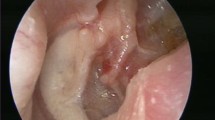Summary
This study aimed to develop a novel surgery classification for an endoscopic approach to middle ear cholesteatoma. We retrospectively analyzed the surgical approaches and outcomes of patients with middle ear cholesteatoma. Middle ear cholesteatoma surgeries were divided into four types and two special types as follows: type I, attic retraction pocket, which only requires tympanostomy tube placement or retraction pocket resection and cartilage reconstruction; type II, cholesteatoma which is limited to the attic or in which endoscopy can confirm complete removal of mastoid cholesteatoma lesions, including type II a, requiring only use of a curette, and type II b, requiring use of an electric drill or chisel; type III, cholesteatoma not limited to the attic, in which endoscopy cannot confirm complete removal of mastoid cholesteatoma lesions, requiring the combined use of endoscope and microscope to perform endoscopic tympanoplasty and “Canal Wall Up” mastoidectomy; type IV, extensive involvement of mastoid cavity cholesteatoma lesions and/or cases with a potential risk of complications, removal of which can only be performed under a microscope for “Canal Wall Down” mastoidectomy. In addition, there were two special types: “difficult external auditory canal” and congenital cholesteatoma in children. In our system, type I and type II middle ear cholesteatoma surgery was completely performed under an endoscope alone. However, estimating the extent of the lesions, determining the choice of mastoid opening and reestablishing ventilation are the key points for an endoscopic approach to middle ear cholesteatoma. The classification of endoscopic middle ear cholesteatoma surgery may benefit the selection of surgical indications.
Similar content being viewed by others
References
Anikin IA, Bokuchava TA. The peculiar clinical features of different types of acquired cholesteatoma of the middle ear. Vestn Otorinolaringol, 2018,83(3):11–15
Hou ZH, Li RX, Yang SM. Application of Endoscopic Techniques in Middle Ear Cholesteatoma Surgeries. Chin J Otol (Chinese), 2017,15(4):393–397
Kuo CW, Wu HM. Fully endoscopic laser stapedotomy: is it comparable with microscopic surgery? Acta Otolaryngol, 2018,138(10):871–876
Kong WJ. Endoscopic ear surgery: flash in the pan or transformative innovation? J Clin Otorhinolaryngol Head Neck Surg (Chinese), 2018,32(6):427–434
Presutti L, Gioacchini FM, Alicandri-Ciufelli M, et al. Results of endoscopic middle ear surgery for cholesteatoma treatment: a systematic review. Acta Otorhinolaryngol Ital, 2014,34(3):153–157
Cohen MS, Basonbul RA, Kozin ED, et al. Residual Cholesteatoma during Second-Look Procedures following Primary Pediatric Endoscopic Ear Surgery. Otolaryngol Head Neck Surg, 2017,157(6):1034–1040
Yung M, Tono T, Olszewska E, et al. EAONO/JOS Joint Consensus Statements on the Definitions, Classification and Staging of Middle Ear Cholesteatoma. J Int Adv Otol, 2017,13(1):1–8
Watanabe T, Ito T, Furukawa T, et al. The Efficacy of Color-Mapped Diffusion-Weighted Images Combined With CT in the Diagnosis and Treatment of Cholesteatoma Using Transcanal Endoscopic Ear Surgery. Otol Neurotol, 2015,36(10):1663–1668
Master AN, Flores JM, Gardner LG, et al. Anatomical Factors Influencing Selective Vestibular Neurectomy: A Comparison of Posterior Fossa Approaches. J Neurol Surg B Skull Base, 2016,77(1):19–23
Cui Y. Transcanal Endoscopic Ear Surgery. Xi’an: World Book Publishing Xi’an Co., Ltd., 2019:9
Louw L. Acquired cholesteatoma pathogenesis: stepwise explanations. J Laryngol Otol, 2010,124(6):587–593
Diacova S, McDonald TJ. A comparison of outcomes following tympanostomy tube placement or conservative measures for management of otitis media with effusion. Ear Nose Throat J, 2007,86(9):552–554
Kalcioglu MT, Cokkeser Y, Kizilay A, et al. Follow-up of 366 ears after tympanostomy tube insertion: why is it draining? Otolaryngol Head Neck Surg, 2003,128(4):560–564
Kaya I, Turhal G, Ozturk A. Results of endoscopic cartilage tympanoplasty procedure with limited tympanomeatal flap incision. Acta Otolaryngol, 2017,137(11):1174–1177
Schröder S, Reineke U, Lehmann M, et al. Chronic obstructive eustachian tube dysfunction in adults: long-term results of baloon eustachian tuboplasty. HNO, 2013,61(2):142–151
Marchioni D, Villari D, Alicandri-Ciufelli M, et al. Endoscopic open technique in patients with middle ear cholesteatoma. Eur Arch Otorhinolaryngol, 2011,268(11):1557–1563
Palva T, Northrop C, Ramsay H. Aeration and drainage pathways of Prussak’s space. Int J Pediatr Otorhinolaryngol, 2001,57(1):55–65
Marchioni D, Mattioli F, Alicandri-Ciufelli M, et al. Trans canal endoscopic approach to the sinus tympani: a clinical report. Otol Neurotol, 2009,30:758–765
Bista M, Mahato NB, Regmi D. Innovative Method of Using Endoscope in Postoperative Canal Wall Down Mastoid Cavity. JNMA J Nepal Med Assoc, 2018,56(211):650–653
Azevedo AF, Soares AB, Garchet HQ, et al. Tympanomastoidectomy: Comparison between canal wall-down and canal wall-up techniques in surgery for chronic otitis media. Int Arch Otorhinolaryngol, 2013,17(3):242–245
Quan Y, Liu J, Liu Z, et al. Detection of hypoplasia of bony cochlear nerve canal by the opening threshold of virtual endoscopy: a pilot study. Acta Radiol, 2014,55(3):318–324
Mahdoufi R, Tazi N, Barhmi I, et al. Bilateral primitive cholesteatoma of external auditory canal with congenital stenosis. Int J Surg Case Rep, 2016,24:108–111
Yin D, Li C, Juan H, et al. Morphological Characteristics of Osseous External Auditory Canal and Its Relationship With External Auditory Canal Cholesteatoma in Patients With Congenital Aural Stenosis. Otol Neurotol, 2017,38(10):1528–1534
Ito T, Kubota T, Watanabe T, et al. Transcanal endoscopic ear surgery for pediatric population with a narrow external auditory canal. Int J Pediatr Otorhinolaryngol, 2015,79(12):2265–2269
Palva T, Northrop C, Ramsay H. Aeration and drainage pathways of Prussak’s space. Int J Pediatr Otorhinolaryngol, 2001,57(1):55–65
Kerckhoffs KG, Kommer MB, van Strien TH, et al. The disease recurrence rate after the canal wall up or canal wall down technique in adults. Laryngoscope, 2016,126(4):980–987
Mishiro Y, Sakagami M, Kitahara T, et al. The investigation of the recurrence rate of cholesteatoma using Kaplan-Meier survival analysis. Otol Neurotol, 2008,29(6):803–806
Crowson MG, Ramprasad VH, Chapurin N, et al. Cost analysis and outcomes of a second-Look tympanoplasty-mastoidectomy strategy for cholesteatoma. Laryngoscope, 2016,126(11):2574–2579
Author information
Authors and Affiliations
Corresponding authors
Additional information
Conflict of Interest Statement
The authors have no conflict of interest.
This work was supported by the Fundamental Research Funds for the Central Universities (No. 2019kfyXKJC039).
Rights and permissions
About this article
Cite this article
Sun, Y., Wang, Eh., Yu, Jt. et al. A Novel Surgery Classification for Endoscopic Approaches to Middle Ear Cholesteatoma. CURR MED SCI 40, 9–17 (2020). https://doi.org/10.1007/s11596-020-2141-0
Received:
Revised:
Published:
Issue Date:
DOI: https://doi.org/10.1007/s11596-020-2141-0




